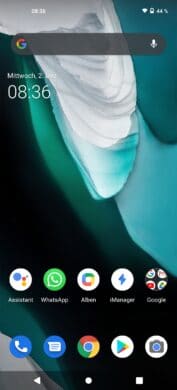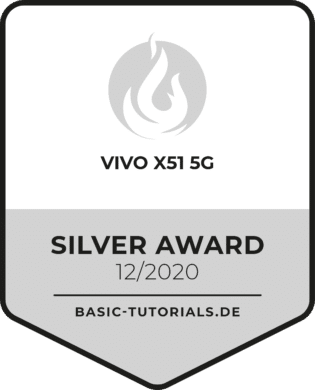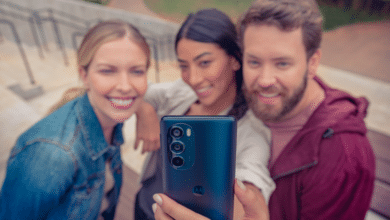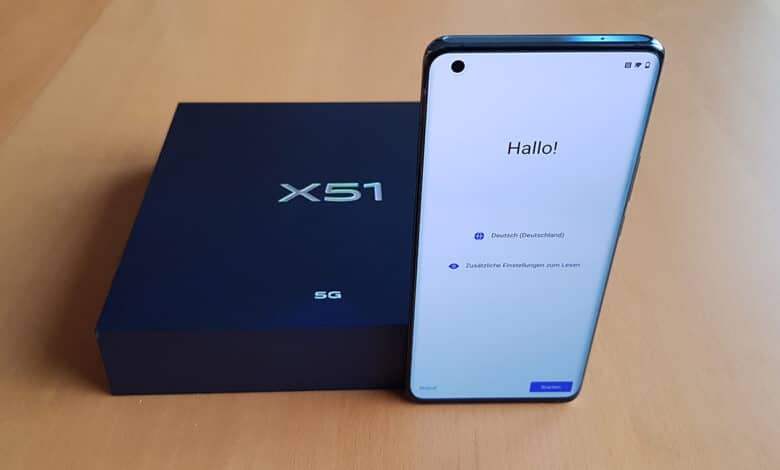
For many consumers in Germany, the name Vivo will not say much at this time. This is quite remarkable when you consider that Vivo has a market share of almost 9% of smartphone sales. This puts Vivo in 6th place worldwide and makes it a permanent fixture in the smartphone business.
In October, Vivo announced that it will also be represented in Germany in the future, emphasizing that it wants to have a sustained presence in the European market.
Accordingly, it is not at all unlikely that the Vivo brand name will have a permanent place in the product range of common electronics stores and network operators in the future.
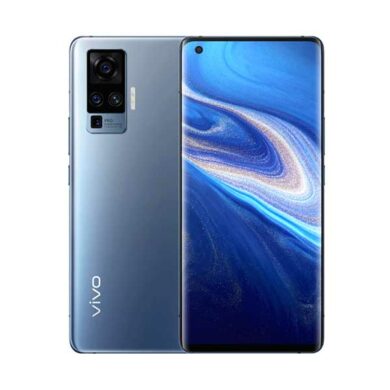
One of the first of these is the Vivo X51, which is already available in China under the name X50 Pro and stands out from the mass of smartphones, particularly with one detail relating to the camera. The following test will show whether the smartphone with integrated gimbal is really convincing.
The data sheet
| Display | 16.64 cm (6.55 inches) AMOLED 90Hz, laterally rounded Resolution: 1 080 x 2 376 pixels (398 ppi) |
| Operating system | Android 10 Surface: Funtouch OS |
| Processor | Qualcomm Snapdragon 765G |
| Memory | 8.0 GB RAM 256 GB memory |
| Dimensions | 158.46 mm x 72.8 mm x 8.4 mm |
| Weight | 181.5 g |
| Front camera | 32 megapixels, f/2.45 |
| Main camera | Main camera: 48 MP, IMX598, gimbal function, f/1.6 Ultra-wide angle: 8 MP, 120 degrees, macro function included periscope camera: 8MP, 5x optical, 60x digital Portrait camera: 13 MP, 50mm focal length, 2x zoom |
| Battery capacity | 4315 mAh, vivo 33 W FlashCharge |
| Price | Price not available * |
The scope of delivery
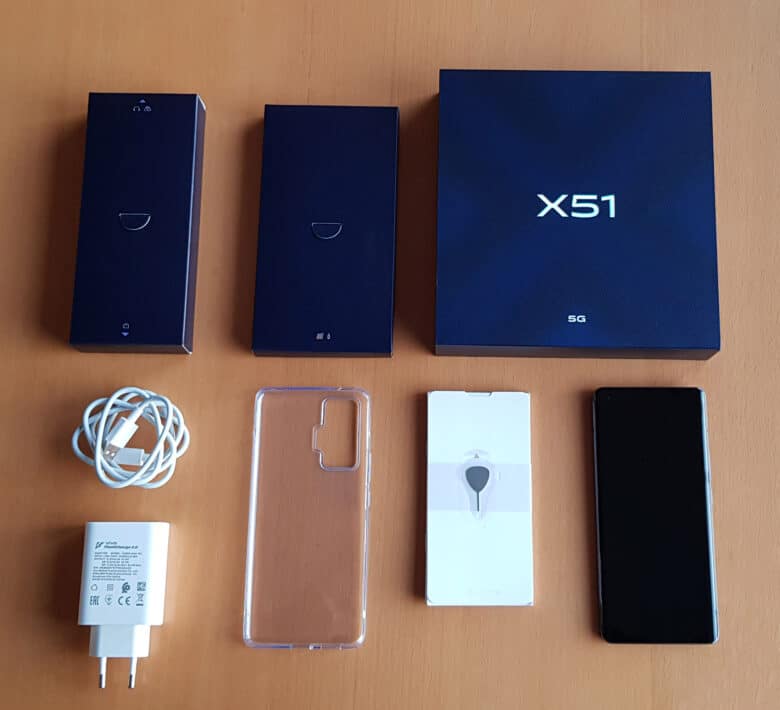
Design, haptics and workmanship
There is no denying that the X51’s design language is reminiscent of competitor models. The form factor as well as the curvature of the glass is a very familiar image on smartphones. However, the fact that it has established itself on the market clearly indicates that consumers are accepting it. Thanks to its slim design, the device fits surprisingly well in the hand, despite a diagonal of 6.56 inches.
Apart from the dominant display on the front, which offers almost 93% screen-to-body ratio, the only thing that catches the eye is the punch-hole camera, which can be found in the top left-hand corner. On the right side of the case are the power button and the volume rocker, both of which have no play and have a good pressure point. A nice thing is that the side controls are also easy to reach with one hand.
On the upper side you can find a microphone, on the lower side a USB type C connector, another microphone, the SIM card slot and the speaker.
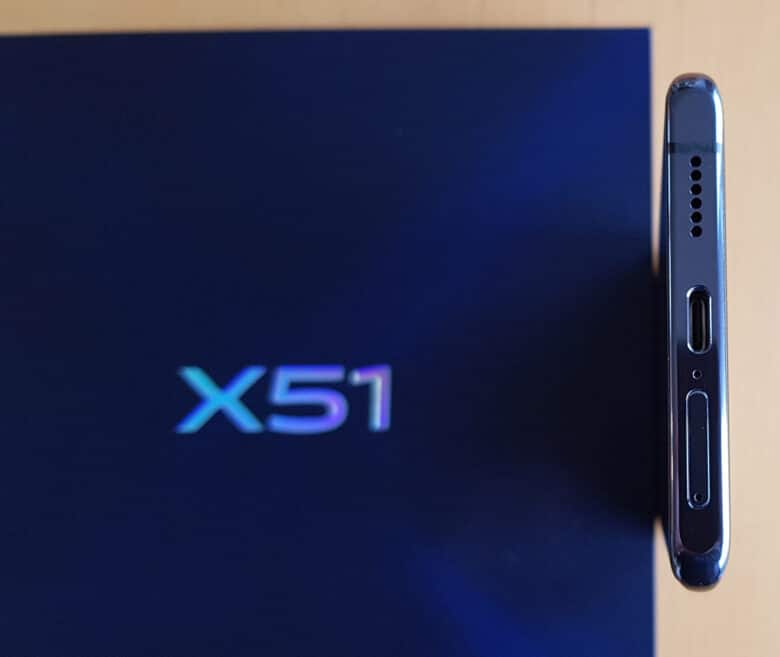
In terms of workmanship, Vivo is on a par with premium manufacturers. Everything feels as if it is all of a piece and the metal frame fits perfectly between the front and back glass. The back is not reflective, but has been given a finish that makes the glass look matt and is much less susceptible to fingerprints.
On the positive side, a display protection film is pre-installed, it fits well and does not impair use. Especially for displays with rounded edges, the application and hold of third-party films can certainly cause problems.
Connectivity
In terms of connectivity, the X51 has no major weaknesses. Bluetooth is built into version 5.1, which will play an important role in the future for navigation within buildings. This is joined by WiFi in the frequency ranges 2.4 and 5 GHz and NFC. The SIM slot is capable of holding two SIM cards. Unfortunately, the USB-C port is only included with version 2.0 – as future-proof as one is with 5G and 5 Ghz, it would have been nice to rely on version 3.1 here as well.
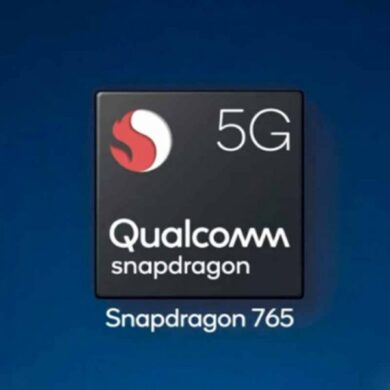
The display
The display is an OLED panel with an FHD+ resolution of 1,080 x 2376 pixels. This corresponds to an aspect ratio of 20:9 and a pixel density of about 398 ppi (pixels per inch). This is complemented by a notch at the upper left display edge, which houses the front camera.
Contrasts are excellent, typical for OLEDs, and the color space is correspondingly large. Only the brightness is not on the level of flagship models. The readability in strong sunlight suffers accordingly. In all other lighting conditions the display cuts a very good figure and media consumption is definitely fun.

To the sides the display is rounded off, which looks quite chic and modern. As with all smartphones with rounded glass, this has, in addition to the advantages of aesthetics, also disadvantages in usability. This is not X51-exclusive, so definitely not a disadvantage per se, but friends of flat displays will probably not be completely happy.
Very pleasant, even if it has become a standard, is the 90 Hz display. You can feel the higher refresh rate when using the smartphone. Menus feel smoother and the system feels more lively. What’s nice is that, in addition to the 60 Hz and 90 Hz options, you can also activate an intelligent automatic function that only switches to the 90 Hz when it is needed, thus saving battery power.
The in-display fingerprint pressure sensor does a good job. It reacts reliably and unlocks the display 95% of the time. In terms of speed, it is not quite up to the speed of a One Plus smartphone, but there is no real criticism of speed.
Multimedia
A large, high-contrast display naturally invites media consumption. It is therefore a bit of a pity that only a mono loudspeaker is installed on the bottom side. The display would definitely have been entitled to stereo sound. The loudspeaker becomes quite loud and sounds very clean up to 70%. Bass is unfortunately a foreign word. So the musical qualities are rather “ok” and would be quite expandable with a successor model.
In the gaming area, an ultra game mode is available. With this mode you can block notifications while you are in a gaming session and the hardware is optimized for gaming.
The example Genshin Impact shows that the Snapdragon 765G also brings a decent performance in games. Only rarely do you feel the difference to its big brother. In situations where there is a lot going on, where many effects are active, the 865 is still ahead. Basically, the 765G is also well-equipped – especially since a game has been chosen that is quite demanding on the hardware.
The battery
The battery has a capacity of 4,315 mAh and is thus properly dimensioned. The battery life can be described as good, although not outstanding. Over one day one comes also as a frequent user, without worrying about the battery condition. However, a second day without a short pause for charging was not possible during the test. A drop of bitterness, which does not fall too much into the weight due to the 33 Watt fast charger, since even short charging phases provide for a tidy energy thrust.
Wireless charging is not available. Whether this is a disadvantage must be determined by the user’s charging habits. Those who have not been charging wirelessly so far may not miss this feature.
The camera(s)
While Vivo’s other features are well worthy of the upper mid-range, the focus is clearly on the camera and it even stands out from the crowd – no other smartphone on the market currently offers a gimbal.
Software solutions usually offer a stabilization of one degree. Vivo points out that up to three degrees are possible with the mechanical solution. Correspondingly, advertising is also done with 300%. And indeed, this is a feature that not only sounds good on paper, but also proves in practice that it offers real added value. Video appears much smoother and even faster movements do not shake the image as much as on smartphones with purely optical image stabilization.
The Vivo X51 has a total of five cameras installed. In addition to the front camera, which has a resolution of 32 megapixels, there are another four cameras on the back, which are prominently displayed. The camera module protrudes slightly out of the case, but does not look too clunky and promises photos on the level of the upper class.
In addition to the above-mentioned camera with gimbal stabilization, there is also an ultra-wide angle camera that offers a macro function, a telephoto zoom, and a portrait camera.
The tele zoom offers a continuous magnification of up to five times the optical magnification. The results are quite respectable and of good quality. It should be mentioned, however, that the Pro camera is only used from a zoom level of 5x, which means that in the range of 2x-4.9x, where the portrait camera is used, the results are sometimes worse than with 5x magnification. In terms of zoom, the Pro camera is quite fun. Even results where digital assistance is used in addition to the 5x zoom achieve very good results. With the X51, this is possible thanks to the hyper zoom up to 60x mentioned by Vivo.
The aforementioned portrait camera comes with a variety of modes, beauty filters and sample poses to serve as a source of inspiration for creative portrait shots.
The pose is placed over the camera UI to give the subject clues as to how he or she should position themselves. Certainly a gimmick, but for some people it might be a nice feature.
The night mode also made a good impression. This is automatically recognized and offered when the smartphone registers that there is less ambient brightness.
The combination of macro and wide angle lens is a bit negative. While the macro shots are quite nice to look at, you have to struggle every now and then to get the shots to look the way you want them to. Separate sensors would certainly have been more user-friendly.
The software
Vivo does not make any big experiments with the software. The in-house Funtouch OS is very close to Stock Android from Google and fortunately free of bloatware. The performance can be described as very good. Hangs or performance losses were not detected in the test. For the German market it is certainly pleasing that Funtouch OS is kept quite discreet and does not have any bright colors or shrill icons.
Conclusion
Vivo is definitely a talking point with the X51. The smartphone is superb workmanship, has a super display, is comfortable to hold and makes a very valuable and high-priced impression. But it is precisely the price that is worth talking about. The RRP for the X51 is 799 Euro at the market launch. This would be quite okay if the competition in this segment was not so strong. In the end it is just the Snapdragon 765G, only 90 Hz, only one mono speaker and only FHD+ – all points of criticism on their own, which could be overcome, but in total there are arguments that make other devices more interesting for a lower price or stronger specifications for a similar price.
A real unique selling point is the camera. Especially those who often make video recordings and are also in motion will be willing to pay a certain extra charge.
But the bottom line is that the success of the Vivo X51 will strongly depend on how the price will develop in the coming months.
Vivo X51 5G
Workmanship
Hardware
Multimedia
Performance
Battery
Value for money
82/100
Great processed smartphone with exciting ideas, which wants to play somewhere between middle class and upper middle class.









